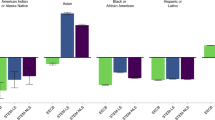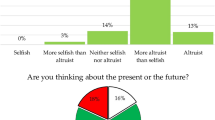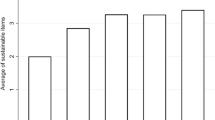Abstract
Racial and ethnic diversity in environmental sustainability advances social equity and innovation, solving social-ecological crises. Yet, Black, Indigenous and people of colour (BIPOC) remain underrepresented in sustainability fields despite high environmental concern. Universities provide pathways to sustainability careers and help diversify the field by making programmes more equitable and inclusive for racially minoritized students. Toward this end, we interviewed undergraduate BIPOC students in interdisciplinary environmental and sustainability degree programmes about their experiences. Their observations reflect a legacy of systemic racism that persists today within environmentalism. Many described motivations connecting ecological and social well-being but lamented limited interdisciplinary and global perspectives in the curriculum. Experiences of discrimination, lack of relatability and limited discussions of race led to feeling isolated and excluded. Support networks, extracurricular participation and BIPOC-specific opportunities improved student inclusion and belonging. BIPOC students hold knowledge unapparent to non-marginalized groups that illuminates pathways to racial equity in environmental sustainability.
This is a preview of subscription content, access via your institution
Access options
Access Nature and 54 other Nature Portfolio journals
Get Nature+, our best-value online-access subscription
$29.99 / 30 days
cancel any time
Subscribe to this journal
Receive 12 digital issues and online access to articles
$119.00 per year
only $9.92 per issue
Buy this article
- Purchase on Springer Link
- Instant access to full article PDF
Prices may be subject to local taxes which are calculated during checkout


Similar content being viewed by others
Data availability
The authors declare that the data supporting the findings of this study are available within the paper and Supplementary Tables.
References
IPCC Climate Change 2014: Synthesis Report (eds Core Writing Team, Pachauri, R. K. & Meyer L. A.) (IPCC, 2014).
Rockström, J. et al. Planetary boundaries: exploring the safe operating space for humanity. Ecol. Soc. 14, 32 (2009).
Butchart, S. H. M. et al. Global biodiversity: indicators of recent declines. Science 328, 1164–1168 (2010).
Brondizio, E. S., Settele, J. & Ngo, H. T. (eds) Global Assessment Report on Biodiversity and Ecosystem Services (IPBES, 2019).
Millennium Ecosystem Assessment. Ecosystems and Human Well-being: Synthesis (Island Press, 2005).
Díaz, S. et al. Pervasive human-driven decline of life on Earth points to the need for transformative change. Science 366, eaax3100 (2019).
Dhaliwal, S. Why are Britain’s green movements an all-white affair? The Guardian (28 September 2015).
Dutt, K. Race and racism in the geosciences. Nat. Geosci. 13, 2–3 (2020).
Taylor, D. E. Gender and racial diversity in environmental organizations: uneven accomplishments and cause for concern. Environ. Justice 8, 165–180 (2015).
Kou-Giesbrecht, S. Asian Americans: the forgotten minority in ecology. Bull. Ecol. Soc. Am. 101, e01696 (2020).
Mohai, P. Dispelling old myths: African American. Environ. Sci. Policy Sustain. Dev. 45, 10–26 (2003).
Pearson, A. R., Schuldt, J. P., Romero-Canyas, R., Ballew, M. T. & Larson-Konar, D. Diverse segments of the US public underestimate the environmental concerns of minority and low-income Americans. Proc. Natl Acad. Sci. USA 115, 12429–12434 (2018).
Macias, T. Environmental risk perception among race and ethnic groups in the United States. Ethnicities 16, 111–129 (2016).
Ballew, M. T., Goldberg, M. H., Rosenthal, S. A., Cutler, M. J. & Leiserowitz, A. Climate change activism among Latino and white Americans. Front. Commun. 3, 58 (2019).
Cole, L. W. & Foster, S. R. From the Ground Up: Environmental Racism and the Rise of the Environmental Movement (New York Univ. Press, 2001).
Walker, B. & Salt, D. Resilience Thinking: Sustaining Ecosystems and People in a Changing World (Island Press, 2006).
Page, S. E. The Diversity Bonus (Princeton Univ. Press, 2018).
Woolley, A. W., Aggarwal, I. & Malone, T. W. Collective intelligence and group performance. Curr. Dir. Psychol. Sci. 24, 420–424 (2015).
Taylor, D. E. The State of Diversity in Environmental Organizations (Green 2.0, 2014).
Environmental Scientists and Specialists: Occupational Outlook Handbook (Bureau of Labor Statistics, US Department of Labor, accessed 16 Dec 2020); https://www.bls.gov/ooh/life-physical-and-social-science/environmental-scientists-and-specialists.htm
Krings, A., Kornberg, D. & Lane, E. Organizing under austerity: how residents’ concerns became the Flint water crisis. Crit. Sociol. 45, 583–597 (2019).
Whyte, K. P. The Dakota Access Pipeline, environmental injustice, and U.S. colonialism. RED INK. Int. J. Indig. Lit. Arts Humanit. 19, 154–169 (2017).
Johnson, T. N. The Dakota Access Pipeline and the breakdown of participatory processes in environmental decision-making. Environ. Commun. 13, 335–352 (2019).
Vincent, S. Trends in interdisciplinary environmental and sustainability programs. EM Magazine. 65, 22–27 (2015).
Taylor, D. E. Racial and ethnic differences in the students’ readiness, identity, perceptions of institutional diversity, and desire to join the environmental workforce. J. Environ. Stud. Sci. 8, 152–168 (2018).
Garibay, J. C. & Vincent, S. Racially inclusive climates within degree programs and increasing student of color enrollment: an examination of environmental/sustainability programs. J. Divers. High. Educ. 11, 201–220 (2018).
Volchok, R. Defining Diversity, Inclusion, and Equity to Build Better STEM Communities (Center for Scientific Collaboration and Community Engagement, 2018); https://www.cscce.org/2018/04/18/defining-diversity-inclusion-and-equity-to-build-better-stem-communities/
Gurin, P., Nagda, B. R. A. & Lopez, G. E. The benefits of diversity in education for democratic citizenship. J. Soc. Issues 60, 17–34 (2004).
Gurin, P. et al. (eds) in Defending Diversity 97–188 (Univ. of Michigan Press, 2004).
Charmaz, K. Constructing Grounded Theory: A Practical Guide through Qualitative Analysis (Sage Publications, 2006).
Greenwood, D. J. & Levin, M. Introduction to Action Research: Social Research for Social Change (Sage Publications, 1998).
Strayhorn, T. L. College Students’ Sense of Belonging: A Key to Educational Success for All Students (Routledge, 2018).
Rainey, K., Dancy, M., Mickelson, R., Stearns, E. & Moller, S. Race and gender differences in how sense of belonging influences decisions to major in STEM. Int. J. STEM Educ. 5, 10 (2018).
Finney, C. Black Faces, White Spaces: Reimagining the Relationship of African Americans to the Great Outdoors (Univ. of North Carolina Press, 2014).
Taylor, D. E. The Rise of the American Conservation Movement: Power, Privilege, and Environmental Protection (Duke Univ. Press, 2016).
Stapleton, S. R. Toward critical environmental education: a standpoint analysis of race in the American environmental context. Environ. Educ. Res. 26, 155–170 (2020).
Chaudhury, A. & Colla, S. Next steps in dismantling discrimination: lessons from ecology and conservation science. Conserv. Lett. 14, e12774 (2021).
Sensoy, Ö. & DiAngelo, R. ‘We are all for diversity, but…’: how faculty hiring committees reproduce whiteness and practical suggestions for how they can change. Harv. Educ. Rev. 87, 557–580 (2017).
Hurtado, S., Clayton-Pedersen, A. R., Allen, W. R. & Milem, J. F. Enhancing campus climates for racial/ethnic diversity: educational policy and practice. Rev. High. Educ. 21, 279–302 (1998).
Hurtado, S., Alvarez, C. L., Guillermo-Wann, C., Cuellar, M. & Arellano, L. in Higher Education: Handbook of Theory and Research (eds Smart, J. C. & Paulsen, M. B.) 41–122 (Springer, 2012).
Chaudhary, V. B. & Berhe, A. A. Ten simple rules for building an antiracist lab. PLoS Comput. Biol. 16, e1008210 (2020).
Forrester, N. Diversity in science: next steps for research group leaders. Nature 585, S65–S67 (2020).
Estrada, M. et al. Improving underrepresented minority student persistence in STEM. CBE Life Sci. Educ. 15, es5 (2016).
Barriers and Opportunities for 2-Year and 4-Year STEM Degrees: Systemic Change to Support Students’ Diverse Pathways (National Academies of Sciences, 2016).
Akamine Phillips, J., Risdon, N., Lamsma, M., Hambrick, A. & Jun, A. Barriers and strategies by white faculty who incorporate anti-racist pedagogy. Race Pedag. J. 3, 1 (2019).
Smith, A. in Color of Violence: The Incite! Anthology (eds INCITE! Women of Color Against Violence) 66–73 (Duke Univ. Press, 2016).
Harper, S. R. & Quayer, S. J. Student Engagement in Higher Education: Theoretical Perspectives and Practical Approaches for Diverse Populations (Routledge, Taylor & Francis Group, 2009).
Ireland, D. T. et al. (Un)hidden figures: a synthesis of research examining the intersectional experiences of Black women and girls in STEM education. Rev. Res. Educ. 42, 226–254 (2018).
Deshler, D. & Grudens-Schuck, N. in Handbook of Adult and Continuing Education (eds Wilson, Arthur L. & Hayes, E. R.) 592–611 (Jossey-Bass, 2000).
Patton, M. Q. Qualitative Research and Evaluation Methods (Sage Publications, 2002).
Russell, D. & Harshbarger, C. Groundwork for Community-based Conservation: Strategies for Social Research (AltaMira Press, 2003).
Maxwell, J. A. Qualitative Research Design: An Iterative Approach (Sage Publications, 2005).
Lincoln, Y. S. & Guba, E. G. Naturalistic Inquiry (Sage Publications, 1985).
Crenshaw, K. Demarginalizing the intersection of race and sex: a Black feminist critique of antidiscrimination doctrine, feminist theory and antiracist politics. Univ. Chicago Legal Forum 1989, 139–168 (1989).
Harry, B., Sturges, K. M. & Klingner, J. K. Mapping the process: an exemplar of process and challenge in grounded theory analysis. Educ. Res. 34, 3–13 (2005).
Acknowledgements
We are grateful to P. Metzler for assisting in the creation of Fig. 1. This work is supported financially by a National Science Foundation Grant (DEB-1844531) to V.B.C.
Author information
Authors and Affiliations
Contributions
C.E., B.R., T.S. and V.B.C. conceived the study. C.E., B.R., M.E. and J.M. conducted focus group interviews and provided editorial comments. J.M., M.H., A.H. and K.S. conducted analyses. T.S. wrote the paper with contributions from M.H. and K.S. All authors provided editorial comments on the manuscript.
Corresponding author
Ethics declarations
Competing interests
The authors declare no competing interests.
Additional information
Peer review information Nature Sustainability thanks the anonymous reviewers for their contribution to the peer review of this work.
Publisher’s note Springer Nature remains neutral with regard to jurisdictional claims in published maps and institutional affiliations.
Supplementary information
Supplementary Information
Guide for semistructured interviews.
Supplementary Tables
Illustrative quotes organized by thematic category (Tables 1–4).
Rights and permissions
About this article
Cite this article
Schusler, T.M., Espedido, C.B., Rivera, B.K. et al. Students of colour views on racial equity in environmental sustainability. Nat Sustain 4, 975–982 (2021). https://doi.org/10.1038/s41893-021-00759-7
Received:
Accepted:
Published:
Issue Date:
DOI: https://doi.org/10.1038/s41893-021-00759-7
This article is cited by
-
Utilization of a novel pedagogical framework to create and implement an environmental justice strategies undergraduate course: a case study
Journal of Environmental Studies and Sciences (2023)
-
Role of green financing and financial inclusion to develop the cleaner environment for macroeconomic stability: Inter-temporal analysis of ASEAN economies
Economic Change and Restructuring (2023)
-
Building STEM pathways for students of color to natural resources careers: the Northern New Mexico Climate Change Corps
Journal of Environmental Studies and Sciences (2022)



